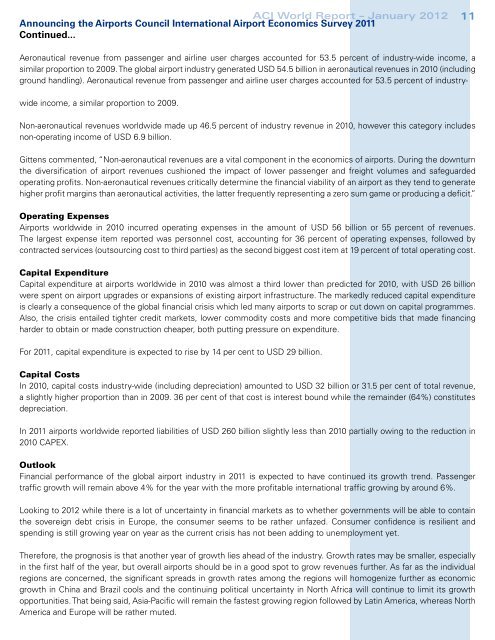ACI World Report January 2012 - Airports Council International
ACI World Report January 2012 - Airports Council International
ACI World Report January 2012 - Airports Council International
You also want an ePaper? Increase the reach of your titles
YUMPU automatically turns print PDFs into web optimized ePapers that Google loves.
<strong>ACI</strong> <strong>World</strong> <strong>Report</strong> – <strong>January</strong> <strong>2012</strong><br />
Announcing the <strong>Airports</strong> <strong>Council</strong> <strong>International</strong> Airport Economics Survey 2011<br />
Continued...<br />
11<br />
Aeronautical revenue from passenger and airline user charges accounted for 53.5 percent of industry-wide income, a<br />
similar proportion to 2009. The global airport industry generated USD 54.5 billion in aeronautical revenues in 2010 (including<br />
ground handling). Aeronautical revenue from passenger and airline user charges accounted for 53.5 percent of industrywide<br />
income, a similar proportion to 2009.<br />
Non-aeronautical revenues worldwide made up 46.5 percent of industry revenue in 2010, however this category includes<br />
non-operating income of USD 6.9 billion.<br />
Gittens commented, “Non-aeronautical revenues are a vital component in the economics of airports. During the downturn<br />
the diversification of airport revenues cushioned the impact of lower passenger and freight volumes and safeguarded<br />
operating profits. Non-aeronautical revenues critically determine the financial viability of an airport as they tend to generate<br />
higher profit margins than aeronautical activities, the latter frequently representing a zero sum game or producing a deficit.”<br />
Operating Expenses<br />
<strong>Airports</strong> worldwide in 2010 incurred operating expenses in the amount of USD 56 billion or 55 percent of revenues.<br />
The largest expense item reported was personnel cost, accounting for 36 percent of operating expenses, followed by<br />
contracted services (outsourcing cost to third parties) as the second biggest cost item at 19 percent of total operating cost.<br />
Capital Expenditure<br />
Capital expenditure at airports worldwide in 2010 was almost a third lower than predicted for 2010, with USD 26 billion<br />
were spent on airport upgrades or expansions of existing airport infrastructure. The markedly reduced capital expenditure<br />
is clearly a consequence of the global financial crisis which led many airports to scrap or cut down on capital programmes.<br />
Also, the crisis entailed tighter credit markets, lower commodity costs and more competitive bids that made financing<br />
harder to obtain or made construction cheaper, both putting pressure on expenditure.<br />
For 2011, capital expenditure is expected to rise by 14 per cent to USD 29 billion.<br />
Capital Costs<br />
In 2010, capital costs industry-wide (including depreciation) amounted to USD 32 billion or 31.5 per cent of total revenue,<br />
a slightly higher proportion than in 2009. 36 per cent of that cost is interest bound while the remainder (64%) constitutes<br />
depreciation.<br />
In 2011 airports worldwide reported liabilities of USD 260 billion slightly less than 2010 partially owing to the reduction in<br />
2010 CAPEX.<br />
Outlook<br />
Financial performance of the global airport industry in 2011 is expected to have continued its growth trend. Passenger<br />
traffic growth will remain above 4% for the year with the more profitable international traffic growing by around 6%.<br />
Looking to <strong>2012</strong> while there is a lot of uncertainty in financial markets as to whether governments will be able to contain<br />
the sovereign debt crisis in Europe, the consumer seems to be rather unfazed. Consumer confidence is resilient and<br />
spending is still growing year on year as the current crisis has not been adding to unemployment yet.<br />
Therefore, the prognosis is that another year of growth lies ahead of the industry. Growth rates may be smaller, especially<br />
in the first half of the year, but overall airports should be in a good spot to grow revenues further. As far as the individual<br />
regions are concerned, the significant spreads in growth rates among the regions will homogenize further as economic<br />
growth in China and Brazil cools and the continuing political uncertainty in North Africa will continue to limit its growth<br />
opportunities. That being said, Asia-Pacific will remain the fastest growing region followed by Latin America, whereas North<br />
America and Europe will be rather muted.

















